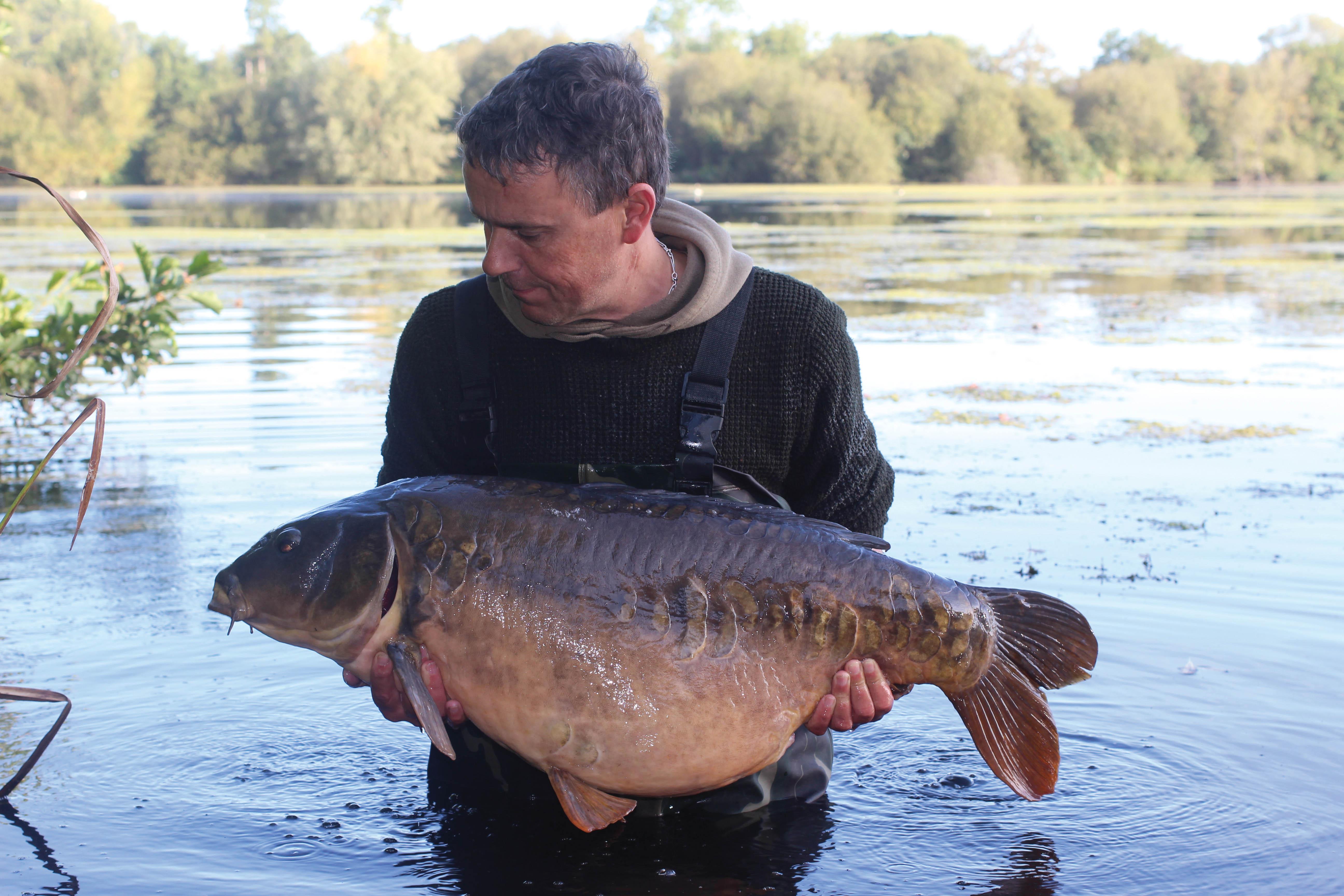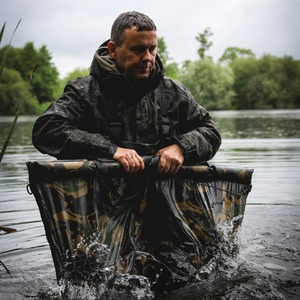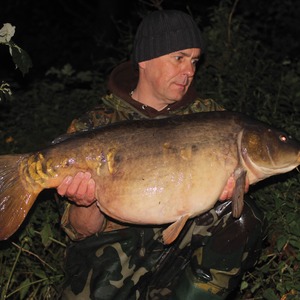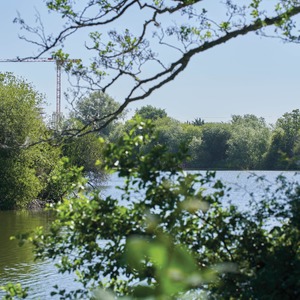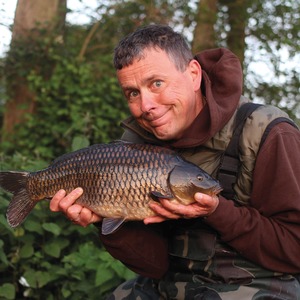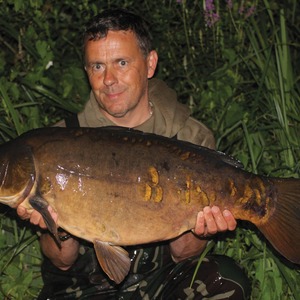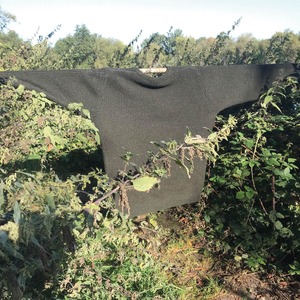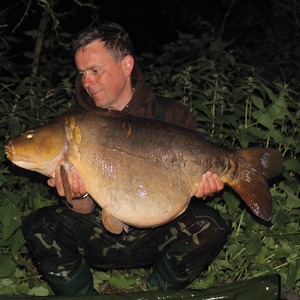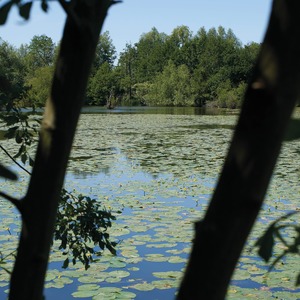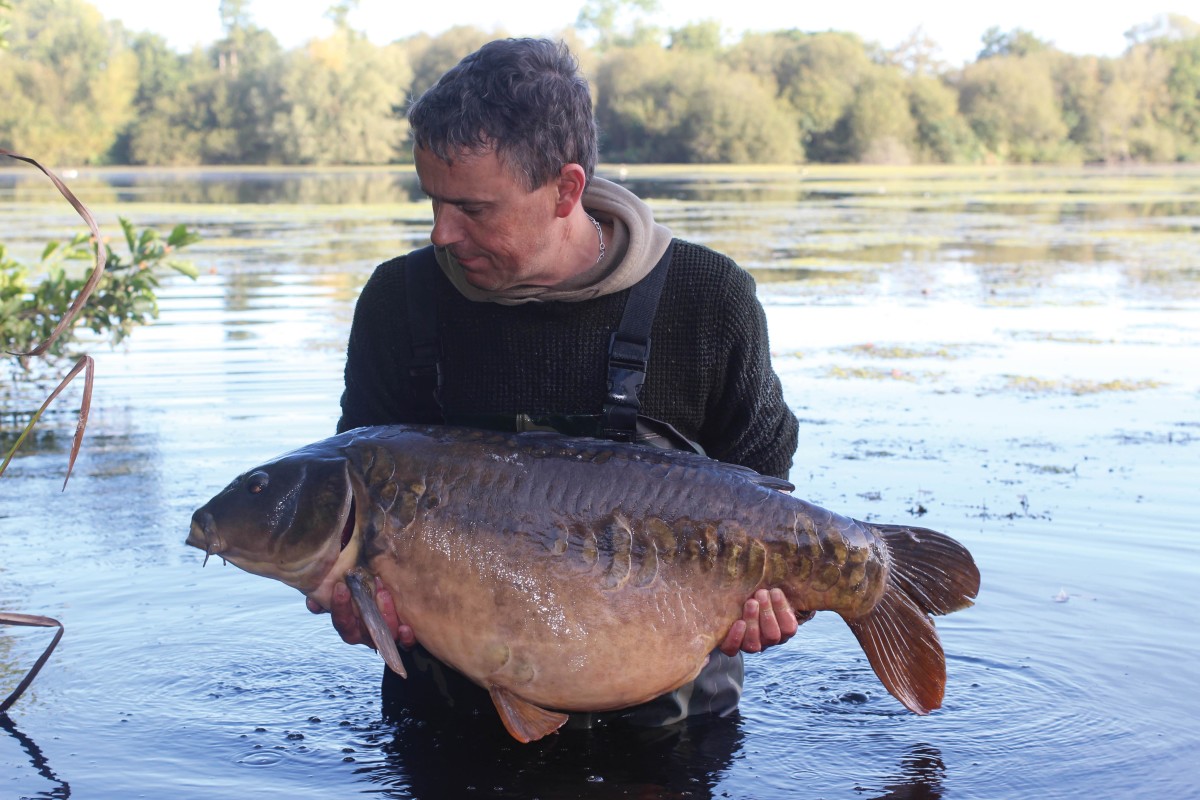
Back On The Big Carp Hunt
It seems to have been a very long winter, and Nigel Sharp's itching to get back on Farnham Flint. We caught up with Nigel once again, to find out how his campaign has gone so far, and what his approach will be, when he returns
Last month was more of a general catch-up, but this time we’d like to dig deeper into your fishing in 2022, and your plans for 2023, focusing mainly on Farnham Flint. For those readers who may not know the lake, could you give us some background on it?
“It’s a Reading & District Angling Association water, and it’s next to Burghfield. It’s probably something like 30 acres. It’s a miniature Burghfield, perhaps, in that it’s not like you can sit at one end and see the whole lake, or sit in the middle and see what’s going on. A big, banana-shaped island separates it, and there’s a bay near the island which you can’t hit. A rope stops anglers casting too far, so there’s a big safe area out in the middle of the lake. Quite often, the fish will sit out there, out of anglers’ reach. There’s also a back bay, which is home to one of the largest lily beds in the country. That’s pretty mad when it’s in full bloom, with it stretching all across the surface. It may have been dug in the fifties, and it’s a very snaggy, mature gravel pit.
“You have everything that usually goes with a gravel pit, like bars and zebra mussels, along with crayfish. Everything’s against you. There are mature trees all around it, some of which have blown over, or have had branches snapped off them. You’ve got Burghfield and Englefield either side, and it’s next to the M4, so if there’s a wind, it can be quite loud. It’s not a heavily manicured lake, so any fallen trees will remain in the lake and provide safe areas where the fish can sit. It can be frustrating. It’s a carp lake that has everything you’d want: lily pads, weedbeds, bars, snags, islands, the lot.”
How hard is it?
“It’s got harder during my time on there. I’ve been on it now for three seasons, pretty much. When you spod out a load of gear and bits and bobs now, one of the last things you want to do is fish a pop-up over the top. If you do, you’ll probably get rigged out as they feed all around you. You’ll either not get a pick-up or it’ll be the last one to go.
“When I first went on there, you could put all that gear out and fish a blatant, highly visible pop-up over it, three or four inches off the deck, and you’d get a bite. Then, after re-casting, you’d get another. During my time on there, though, it’s changed, and now you have to use bottom baits, and trim them right down. Your hookbaits have to sink slowly or be smaller. The lake’s got busier as more and more anglers have taken an interest in it. More bait’s gone in, particularly smaller items, as it’s generally a Spomb water. As a result, it’s become much harder to get bites on a pop-up over that bait. As I say, you have to trim your baits down to get a bite.
“I’ve caught a lot of the fish twice, some three times and a few four times. Now, I tend not to chase the shoal. I try and put myself in a place where I can catch the fish I want to catch, and that’s kind of made things harder for me. I wouldn’t say that it’s super rock-hard, but I wouldn’t say it’s an easy water either. It sits somewhere in the middle.”
What’s the stock like?
“That’s a tricky one. Originally, there were around 30 Leneys in there, but where they came from I couldn’t tell you. Chris Ball told me that there are no stocking records, so the fish could’ve come from elsewhere. Who knows? That was the original stock, though. It’s typical of what I like in that it’s about one fish per acre.
“Over the years, some of the fish have died, and some have ended up in Burghfield. These things happen. In years gone by, fish would get moved about. The club has stocked it since, and fish have come from several sources. Some will try and tell you that there are 200 carp in there. Personally speaking, given what I’ve caught and the number of repeat captures I’ve had, I’d be surprised if it holds more than 60.
“Given that they’re not all the same strain, it’s quite nice. They’re not like peas in a pod and if you get a bite, you don’t know what’s on the end. It could be a common that was stocked the same year or it could be a big common. It could be a dumpy mirror or a long one. There are only three of the old Leneys left, so again, it’s nice. All the fish are individuals.”
Talking of big commons, tell us about the largest in there, the Pristine Common. When did you first hear about it?
“I first heard about that particular fish before I went on there. I was fishing elsewhere when ‘Topper’ Knight caught it. At mid-forties, it was a bit of a surprise. He’d caught the other big common, a fish I’ve had a couple of times myself, and then he had that one. Having seen the photos of both, I kept the fish in the back of my mind for some point in the future.
“When I was fishing ‘Engy’ a few years later, in 2018, I found myself looking across ‘Flint’ of an evening. I saw fish show and remembered that there were a couple of big commons in there, and I thought I’d give it a go. The Pristine Common, as it’s called, was about 45lb back then. Now it’s around ten pounds heavier!
“It’s been caught a few times, but not a lot’s known about it, because historically, it wasn’t a big fish. I spoke to a chap who caught it at around 36lb a few years before Topper had it. Again, where it came from I don’t know. Like a few others, it may have come in from the Blue Pool, years ago. From what I can work out, it’s been caught only eight or nine times. That’s my kind of carp. What gives me the buzz is going after one that is almost impossible to catch. You can liken it to the Burghfield Common, which as far as I know, has only done around 14 captures. Such few captures make it more special than, say a fish which has done 60, 80 or 100 bites.”
It sounds like Burghfield and the Pit 4 campaign all over again…
“When I was on Burghfield, the Common had done only three or four captures before I had it. There wasn’t a lot of information available, so you had to work it out for yourself. Pit 4 was the same with Martin’s Fish. I managed to catch that when it hadn’t been out for about five years. The buzz from catching a fish which hasn’t been caught for years is so much greater. You don’t know what it’s going to weigh when you have it in the net. If you catch one that does five or six captures a year, you almost know what you’ve got as soon as you look at it in your net.
“In all these respects, there are a lot of similarities with ‘the Pristine’. It seems to be getting bigger and bigger whilst I’m on there. Hopefully, I’ll have my day.”
Is it a fish that’s seen regularly, and are there particular areas where it shows up?
“I’ve seen it a few times and I’ve watched it feed. It’s kissed the bottom literally an inch away from my hookbait before, in the margins. I had a rig down there and it went for my hookbait, but it missed it.
“It does get seen, and there is an area it likes to frequent. How often it feeds there I don’t know, but it’s been caught from that area a few times. I think three or four of its captures have been from where it’s often seen. It hasn’t, though, done enough captures for you to draw conclusions from.
“A lot of anglers say that if you want to catch the Pristine Common, you have to fish around the back bay, but I’ve done my homework and know that it’s done captures away from there. There’s a swim I targeted a bit last year and I think it’s now done three captures from it. It’s done another couple of captures from a swim a little bit further along, and another right up the other end of the lake, where apparently it never goes.
“I’ve seen things like this in the past, like on the Car Park Lake. The Big Orange could often be seen in the Gate Swim’s snags, but it very rarely got caught from there. It was vulnerable when it was out in the pond, so we’ll see. As I say, I think it’s too early to draw any conclusions about exactly which swim you have to be in to catch it.”
You’ve touched briefly on how you started on Flint, but can you go into your approach in a little more detail, and how things differ now?
“From the off, I kind of knew how I wanted to fish it. I put a lot bait out, invited everything to the party and cleared areas in the weed. When I started, the lake wasn’t too busy, so I kept two swims at opposite ends baited. I then went on the wind, as you would with any other big pit.
“Things are different now, though, and there have been a few rule changes, given the amount of bait that’s gone in. You can’t pre-bait now, and you can’t load your swim before you leave, safe in the knowledge that it will be left alone. When it comes to feeding the swim, though, my approach has pretty much remained the same. I know they like eating it, and it’s just been about tweaking the rigs you fish over them to get a bite.
“I’ve tried different tactics. For instance, I’ve fished less particle and more boilie. You seem to get fewer bites when you fish with just boilie, but that’s the direction I might be going in, because I’m not after loads of bites. I have a rough plan for this year, and have something new at my disposal: Soluble Boilies from Outlaw Pro. We’ll see whether they work. They’re a way of getting masses of attraction out there in the same way as you would by fishing just boilies, really. It’s something that’s not been done to any great extent in the UK, and on these pressured lakes, anything that’s different to what everyone else is doing is worth a go, isn’t it? That’s where my head is. I’ll be mixing soluble boilies with normal boilies, rather than relying on lots of particle.”
Can you bring us up to speed with what you’ve caught since the start of your campaign, and run through your key captures?
“I think I’ve had three years, and three good runs at it. I started in 2019 and fished it a bit last year but not the year before. I took a bit of a break from it then, just doing the odd bit of fishing on there.
“Initially, all I wanted was to catch a forty-pounder. I did that within about a month of starting, when I banked a fish called Smiley. That fish became a bit of a friend of mine. Sadly, it’s since passed away, so I won’t be catching it again, although that’s almost a relief in some ways.
“Moving on, I wanted to catch one of the two big commons that Topper had. There was the original big common, a proper ol’ Trojan with its twisted scales and the like. It’s still going strong, and I’ve caught it twice. I had it 43lb 12oz at the end of my first summer, and actually, I was quite surprised by how long it took me to catch it. I’d been fishing there since April and I banked it at the end of August. It’s one of the friendlier fish, so I thought I’d have caught it sooner.
“I caught a fish called Carol, at forty pounds and a few ounces. At the time it was quite a rare visitor to the bank. I lost it at the net in the spring and I was gutted. It got caught up in another line and managed to unhook itself, and I could see which fish it was. I finally had it in the September, bracing it with one of the old Leneys. I was well-chuffed to have had it after losing it earlier in the year.
“After catching Smiley a few times, I’ve been slowly going through the stock. There was the high-backed common, a thirty, which I’ve also had a few times. Another fish I really wanted to catch was the Long Common. It has an incredible mouth, but unfortunately, when I had that one, my photos weren’t really that good. It was nice to catch it, though, as it was another that was on my hit list.
“Going back, one of the first I had out was one of the old Leneys. It was only around twenty-three pounds, but it was nice to catch it, and have two of the three. Another one I had was a fish I call Scott’s Linear, which others refer to as the EastEnder’s Linear, because Scott Maslen caught it. I had that one a couple of years ago. It’s another rare fish and is known for knocking around with the Pristine. It was quite a buzz to bank that one, as I thought I might be close to catching the one I really wanted out of there.
“I caught the big common again a couple of years ago, and whilst it was a repeat capture, I had it at a big weight. At 48lb 8oz it’s the fourth-biggest common I’ve caught. It was nice to have at a big weight, rather than spawned-out.
“I’m trying to think of others I’ve had, but many haven’t been named. It’s one of those lakes that has a number of nice old commons, and I’ve had a few of them.”
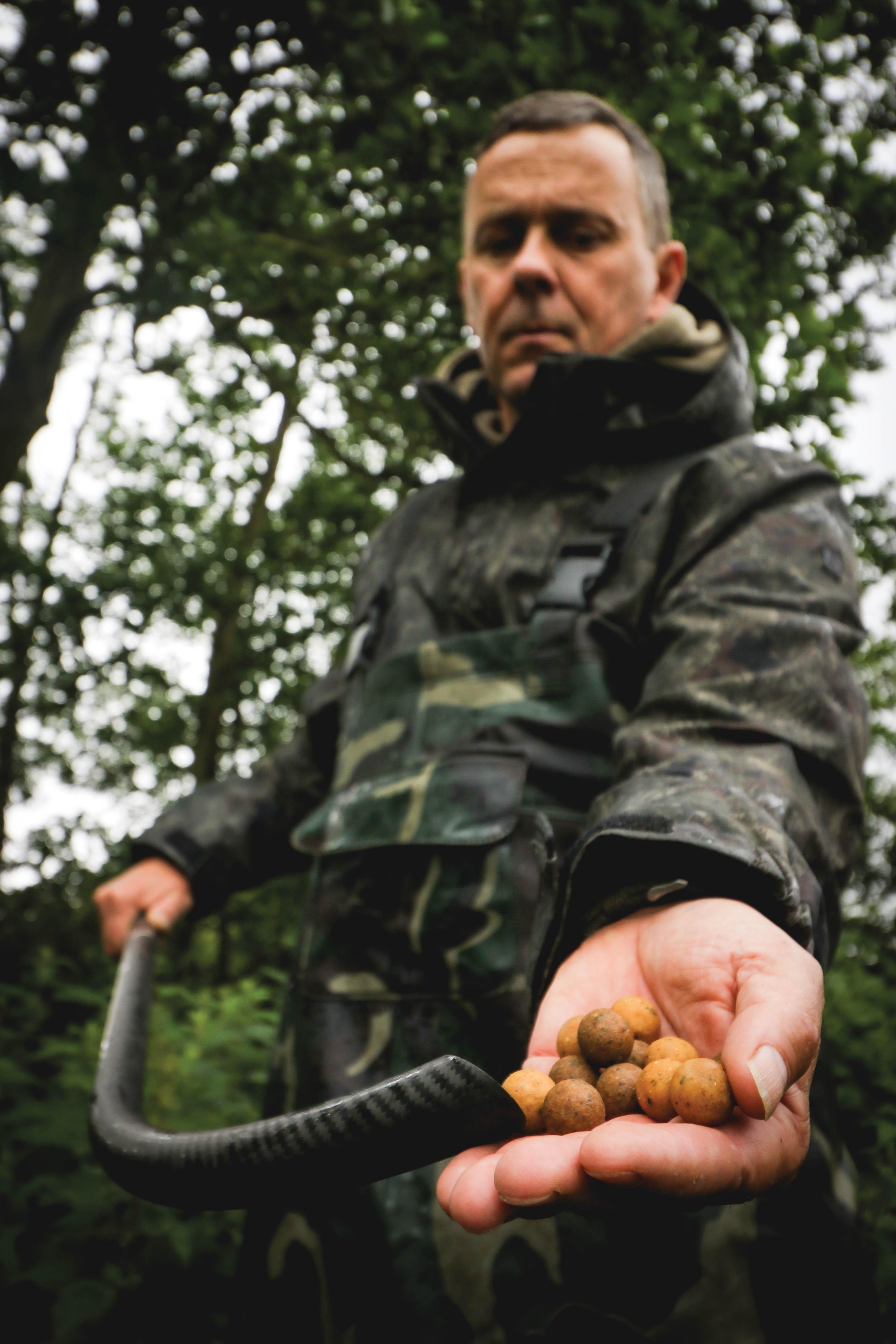
Have you noted any patterns emerge from your captures? You said that you’ve baited particular areas, so have you learned anything in particular from how you’ve baited and what you’ve caught?
“I’ve learned that one of the areas I baited fishes best when all the weed rafts come up. The fish hold in the open water there, rather than run for the snags. During the day, you can see their backs breaking the surface. When the weed’s up it’s prime time, and you can make the most of those areas. I’ve caught a lot of fish from one of those spots, but I don’t believe I’ve come close to catching the Pristine from there. That may change, though, because Smiley, which I caught three times from there, has now passed on, as I’ve mentioned. The pecking order changes, and something similar happened on Burghfield. I had a fish known as Cut Tail, which always seemed to be first on the bait. As soon as it passed away, though, other fish like the Double Belly and Three Up, Five Down started getting caught a bit more. I believe to this day that Cut Tail’s passing played a part in me catching the Common. It upset the balance and the pecking order changed. Perhaps the trickier ones become more vulnerable as a result. That’s one pattern I’ve noted.
“Another is that the Pristine, whilst it doesn’t seem to do a lot of captures, will do one after the other pretty quickly, and then that’ll be it for a while. In the autumn it might come out twice, and what I’ve noticed is that the first of the two captures is generally from the back bay, where the pads are dying off. If it does that bite, a week or two later it’ll be caught from open water. It’s as though it’s been spooked from where it basks and chills out.
“These are things you take on board and retain for the future as you try and compute what’s going on. Whether that fish has been spooked from the back bay, given its capture, and has then become vulnerable out in the open water I don’t know. Sometimes anglers descend on an area where a fish has been caught from, and that might have pushed it out, I don’t know. As I say, these are things I need to try and weigh up, but it’s happened a couple of times.”
Has your approach been similar to that on Pit 4, where you fished three on a spot as you worked a particular area? Have you been fishing it like that, or spreading your bait and fishing different areas?
“If I’ve had three rods out, then pretty much, they’ve all been on different spots. Occasionally, I’ll put two on a spot, but a lot of the fishing is at distance and over weed. If you have more than one rod on a spot, hooked fish can kite and pick up your other line, and that causes absolute chaos. It’s a nightmare trying to bring a fish in that’s trailing weed and another line, and that’s how I lost Carol earlier in the campaign. In the swim where I lost it, though, you’re almost forced into fishing three on a spot. I learned there, to keep the lines away from each other, and to have different spots for each rod.”
Do you go through a process to ensure that each rod is done as well as it can be? Do you find each spot, perhaps, and then get all three rods ready before you then cast them out, or do one at a time?
“I’ve done my homework on the lake, so I tend to know where I want to fish. I know where the rods are going to go as I enter a swim, so I’ll rig each one, and once they’re all ready, wrapped up and have baits on, that’s when I get them all out. Then I bait up over the top of them.
“I tend to visit the swims beforehand, and will have had the marker float out and have the wraps noted, before I fish later on. I don’t like chucking a lead about when I’m fishing, because I’ll feel like I’m killing the swim by pulling a marker rod through it.
“I don’t really use my phone or anything, because the information will end up getting lost. I keep it all in my head. I’ve got a good memory and I rely on that. As I say, I’ll get all three rods ready and wrapped up before I cast them out.”
And what about baiting up?
“I have a process for that. Say I have one rod at eight wraps, one at fourteen and one at nineteen. I’ll put the rod out at nineteen wraps and then count it back. I’ll clip it at fourteen, and clip it again at eight. I then bait up over the closest rod first, unclip it, bait up the middle rod, unclip it again, and finish off with the one at nineteen wraps. That’s just how I do things. It’s efficient and I can get it done quickly.”
How quickly, then, can you get all that done, from wrapping up the first rod to having the last one baited?
“Probably about an hour, tops, and that’s without going mad. I don’t just sling a rod out. I make sure I get the drop and hit the clip right. Sometimes a rod will go out bang on, first chuck, sometimes it takes ten chucks. If you’re fishing at twenty-five, thirty wraps or more, and you have to crank the rod back through weed and then have to pick it all off your line, it can take a bit longer. I like to make sure everything’s right, though, because that rod might be out there for two or three days.
“Sometimes, on big lakes, it can be a bit of a nightmare, given the crosswinds, weed rafts and the like, but generally, it can still all be done in under a couple of hours. If I can get it all done in an hour, including a nice bit of baiting up, then I’m quite happy.”
How tight to do like to be with your baiting up? Do you look to land your spod, say, within an umbrella-sized area every time, or do you spread it around?
“If I was putting out fifteen to twenty medium-sized Spombs, I’ll be happy if three land right on the hookbait. The rest can be within a rod-length of it. If one goes out and it’s more than a rod-length away, I tend to leave it, as it won’t really bother me.”
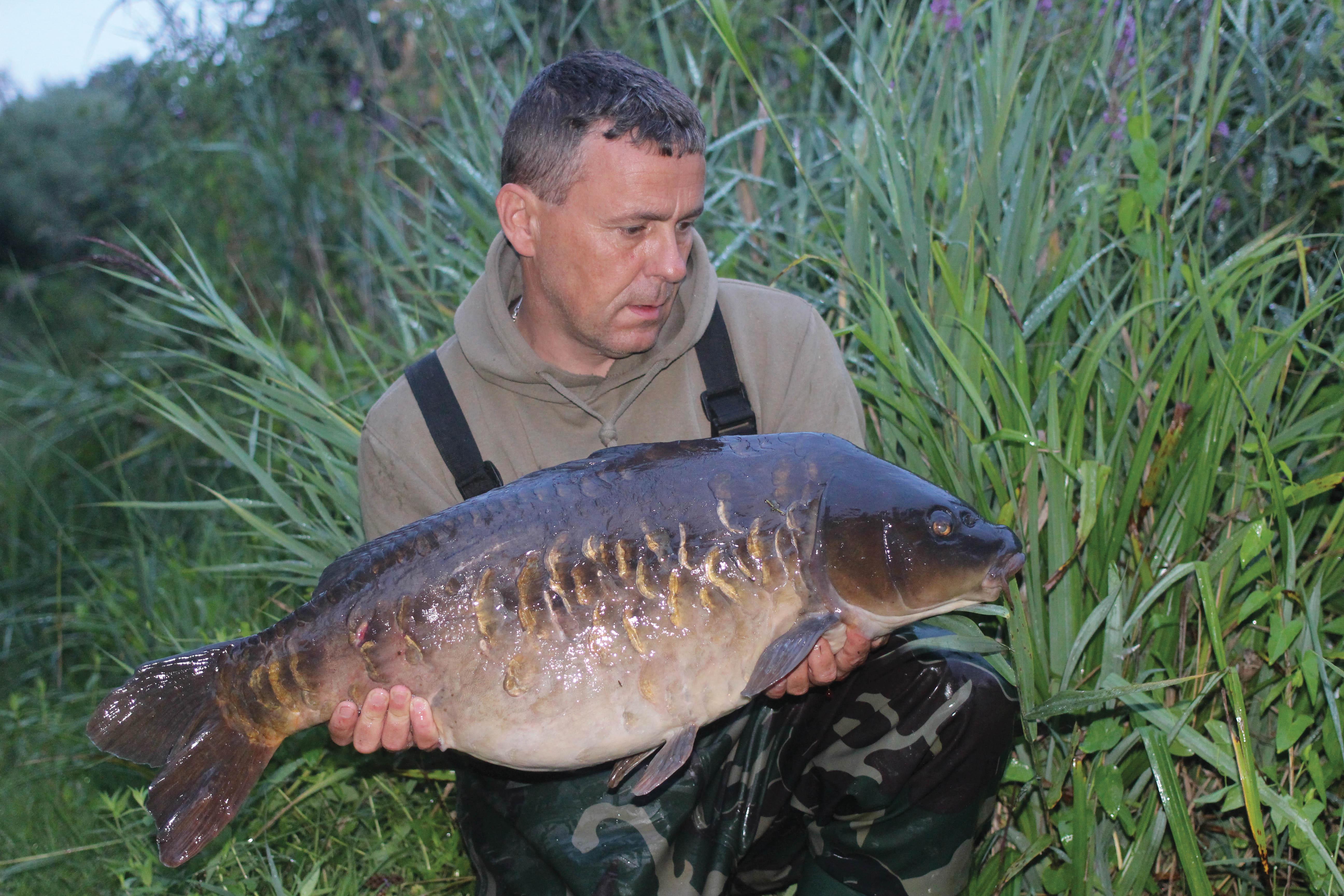
You mentioned earlier that when you first started, you could put out a lot of mixed seed and would get a bite from a pop-up fished over the top, whereas now, pressure has resulted in their feeding habits changing. What changes have you made?
“I came off the pop-ups and went on a hardened, 15mm hookbait tipped with a bit of fake corn, or perhaps a large tiger nut tipped with a fake one. I ended up looking for the smallest tiger nut I could, and I’d tip it with the smallest rubber tiger I could find. They’d fizz all over me for hours and I wouldn’t get a pick-up, so I did what I did, just to try and get a bite.
“During Covid, when a lot of people were furloughed, it was like everyone wanted to be a full-time angler. It was nice to see everyone out, but the knock-on effect was a busy lake, with everyone Spombing out bucketloads of cheap particle. Because of what everyone did, me included, the fish became conditioned to feeding on smaller items. The fishing became very hard. I used watercraft and I observed what was happening when I managed to get in swims. I’d have fish feeding all over me and I could see that I was getting turned over by them. That’s when I started to fine things down, just like a match angler would.”
Did you change anything else, or was it just your hookbaits you tweaked?
“I don’t tend to use many different rigs. On weedy lakes I usually use D-Rigs for bottom baits. They tend not to tangle. All I have to do is cast them straight and get the drop. I don’t really use braided hooklengths, and I stick to what I know.
“You can only change one thing at a time as you try and find out what gets you the bite. If you change two or three things, you won’t really now what actually brought the bite. For me, it was all about coming off the pop-ups to start with, and going on the deck. That brought me some fish, but I was still seeing a lot of feeding activity. I felt that I could still do better, and that’s when I started using smaller hookbaits and balancing them out more. Had those changes not have worked, then I might have looked at my hooklinks and the rest of my set-up. When the fish aren’t moving about much, and they’re sucking in and blowing out baits, the D-Rig’s perfect. I don’t want a turn-and-grab kind of set-up, because the fish have to move off, and they weren’t doing that.”
When will you venture back over there for your first session this year?
“When I was on Burghfield, I walked the lake through the winter. It’s something I’ve always done, and even if it’s frozen over and there’s snow on the ground, I’ll still go and walk it. I want to see the water when it’s at its rock bottom, totally shut down. I’ll walk it regularly until I see fish in the edge, or signs of fish. Then I’ll get the rods out, and that, to me, is a better way of doing things than saying, perhaps, ‘Right, I’m starting back again in February,’ and then sitting it out in a bivvy, two or three nights a week, just hoping to be there when it happens.
“I’m faster on my feet when I haven’t got my rods with me, and I can walk it and walk it and walk it. Because it’s a local water, I can go down very regularly, and I’m just waiting for those signs. It’s mid-March now, and I’ve just started to see the odd little sign. My feet are getting itchy and I can’t wait to get down there with my rods. I believe I’ll be down there within the next week or so to fish it.”
And how will you start? Will it be single hookbaits?
“I’ll start off where I’ve seen signs of fish, and will hope to see more. Generally, I’ll cast hookbaits to those areas. If I feel the need to put bait out, I will. I don’t think I’ll be loading a Spomb with particle, pellet and God knows what, though. I’ll just try and nick a bite, but if I see activity and feel that they need feeding, I will give them a bit. There’s no pre-baiting, though, as I’ve said, so it’s a matter of remembering where you’ve fed, and hoping that you can get back in the same swim in the future.
“I may not see any fish show during the sessions in the next few weeks, but I might stick some bait out, so at least I’ll think that I’ve got something from them. Whether the birds clear it up or the fish get on it, the areas will started to get cleaned off and prepped, and that’s how I roll. Come May, when I know they’re beginning to feed properly, that’s when I’ll start to give them a bit.”
